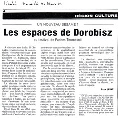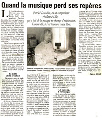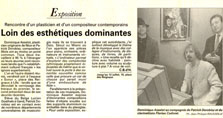minimalist composer Patrick Dorobisz - Computer music, Experimental Music, Minimalist music, New contemporary music
CD : Le marteau double Of Phase & Fantasie
"We are either going to dissolve as a human race or we are going to break through into a new understanding of what it is to be a human being." ~ Terry Riley
"Music is a means of Rapid Transportation" ~ John Cage quote
"If listeners aren't carried away to Heaven, I'm failing." ~ La Monte Young
I set out to listen to this CD at the end of the evening in the dark on the couch late at night. I already knew this music was beautiful and inspired images in my imagination. I suppose it was my intention to drift off to sleep. Soon I found myself listening too deeply, and the sound began to lead me somewhere deeper than a dream. I sat up and began to rock a little to the pulse. I began to have a dialogue with the music. Some of the answers were astonishing. I was on a journey that would last 70 minutes full of surprises. I wasn't going to be able to sleep. I started to smile.
I asked Patrick Dorobisz for his influences and he told me Arnold Schoenberg, Terry Riley, and John Cage. In another email he listed 1970's influences Pink Floyd, Jimi Hendrix, Terry Riley, J.J. Cale, Kraftwerk, Softmachine, and Ashra Temple. In 1981 or 1982, he was listening to Bob Ashley, David Antin, Meredith Monk, Philip Glass, and La Monte Young. Most telling is his statement: "I like a musical universe with all the musical cultures, not just occidental." With these and other colors available to him, Dorobisz has created music that gives me the joy of discovery through layer upon layer. The six titles on this album each offer a different mindscape, and together they are a reminder of how far music can take my imagination without leaving my heart to go hitchhiking somewhere else.
He is credited with developing "an aleatoric repetitive music (rhythmic dephasing of sound sources), by using the analogical electronic means of the time." What that amounts to for the listener is less daunting that it may sound. The most important thing to know about any composer is how he or she repeats musical ideas. Patrick's music moves quickly to a rhythmic plateau, and he includes "events" that can provide the listener with some delightful surprises. Quite simply, the pulse isn't the only story he has to tell. Dorobisz provides Rapid Transportation to a Heavenly place. A special delight comes from the realization that the title piece is played live. The video is available for viewing on your computer, so you can witness the flesh and blood creation of this particular magic bus.
Best of all, this CD paints from a broad palate, taking the listener places that matter on acoustic and electronic conveyances. If you have been listening exclusively to pop music, where a cowbell might be an astonishing choice, you are in for a treat. Patrick Dorobisz paints with a rainbow of colors and textures unavailable to the commercial musician. The composer Lucien compared the repetitions in Dorobisz music to folk music, because all folk music is repetitive. There is also a sense of the familiar in my opinion. This is music you can hear deeply.
LE MARTEAU DOUBLE acknowledges the great acoustic "minimalist" pioneer Terry Riley, without sinking into mere reverence for the form. Though it begins with a single repeated note the rich wooden sound of a marimba and the steely rhythm of a xylophone and the percussive melodic tone of a piano take the listener quickly into the twinkling heavenly pulse that suggests a rainbow in curved air. This is a piece for large ensemble with the strength of strings and double reeds. A flute embellishes the soundscape, and takes its turn at the fore. In the space of nearly 12 minutes Dorobisz completes the transformational journey through the orchestra, into a place where plucked strings can pop like bubbles and mental pictures form and dissipate to a delightful pulse. The title of this piece may suggest a double hammer, but I find myself imagining Thor playfully swinging a hammer made of stars. Wherever this thing takes you, there's joy.
P.S. Patrick Dorobsz sent an email clarifying that the double hammer here is a reference to the two felt hammers of the keyboards—one acoustic piano and one electric.
QUATUOR NO. 3 is influenced by the music of J.J. Cale. The sounds here are performed on plucked and bowed strings. No particular J.J. Cale song comes to mind, but there's something magical about listening to this string music with that other music in mind. The warmth of strings is explored at several angles, and with a good measure of wonder in the slower moments. There is an occasional dying fall, and at least one significant period of acceleration bringing the strings to a dervish speed. Patrick ends the piece with a torrent of expressive bowings.
COMPUTER SANATE FOR VIOLIN AND VIOLA is a rare marriage of acoustic and electric sound that pits neither against the other. Dorobisz writes this electronic music using Sibelius to provide the notation. "In general I play the formulas on my piano. (If I want to say something in music, if I have an idea, a concept.) After I draw all my music (the gesthalt), I write with Sibelius. After I go in my studio and I work, never I improvise." Patrick is an artist, as well as a musician. The drawings of the music are beautiful in themselves, and provide the "gasthalt" for the sound. The music he is able to produce with this fascinating artful process takes the mind where few other vehicles are capable of going. It may be like exploring a painting in sound as literally as I can imagine. This all reminds me for some reason of the line from the Amazing Journey in the rock opera Tommy: "Come on the amazing journey, and learn all you should know."
LE GAI SAVOIR is an excursion into percussion as infectious and arresting as the Kalimba or thumb piano. I cannot resist including the picture of the laughing Jesus, though Dorobisz may not truly be suggesting that image in this music. There is a woody resonance here that can't be bad for your heart.
BALTIC SNAKE hisses its way into a sky saw of an electronic landscape. There is a sense of menace in this darkened world. There may be ghost tracks modifying the acoustic sounds, and the electronics play well with the strings and bowed metal. There is a haunted feeling to this piece reminiscent of the Gayne Ballet Suite, or some of Lygeti's cloud pieces—each of which can be found on the soundtrack to 2001: A Space Odyssey. A few of the electronic sounds have a bite to them, or a sting. This piece has both a sense of wonder and foreboding, and ends with the wooden sound of water dripping, and finally the chicks and pops of electronic rain. The springy decay of a Jew's Harp played from the keyboard adds to the trippy sound. This piece employs the extended tonality of a Schoenberg tone row, with a dollop of humor in the terrifying mix. There is warmth along the way but this excursion may not be for the feint hearted.
L'ORPHEON DE JADE is an ascending stair in the manner of Terry Riley. The plucked strings and upward moving piano and plucked strings suggest another stairway to a different heaven. The steady tick of rapid pulse provides the framework for increasing rhythmic complication and electronic invention. The result is imaginative and powerful.








